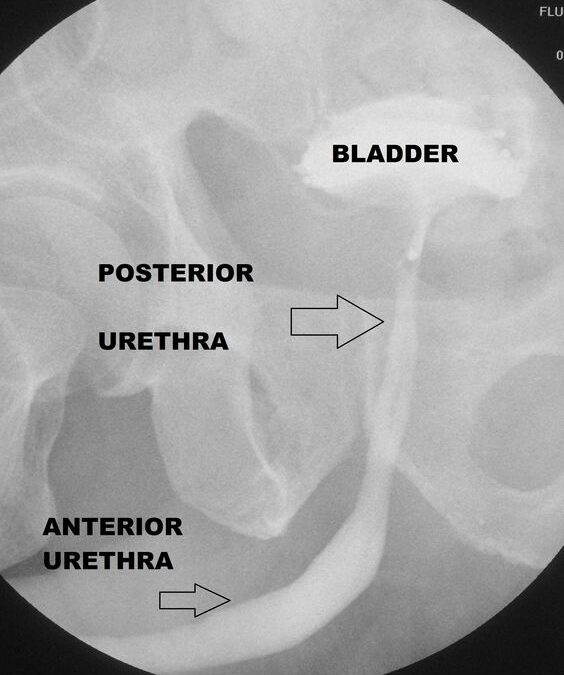What Is Retrograde Urethrography(RGU) ?
Retrograde urethrography is a medical imaging procedure used to visualize the urethra, which is the tube that carries urine from the bladder out of the body. It is typically performed when there is suspicion of a urethral injury or stricture (narrowing) that may be causing urinary problems.
During retrograde urethrography, a contrast agent (a dye that shows up on X-rays) is injected into the urethra through a catheter, which is a thin tube. The contrast agent fills the urethra, making it visible on X-ray images. The procedure is called “retrograde” because the contrast agent is injected in a direction opposite to the normal flow of urine.
Retrograde urethrography is usually performed by a radiologist in a hospital or radiology clinic. The procedure is generally safe but may cause some temporary discomfort or minor side effects, such as a sensation of fullness or mild pain during the injection of the contrast agent. In rare cases, there may be an allergic reaction to the contrast agent, but medical professionals are prepared to handle such situations.

Indication Of Retrograde Urethrography(RGU).
– Urethral stricture.
– Urethral obstruction.
– Urethral tears.
– Suspected urethral fistula.
– Pelvic trauma
– Urethral diverticula.
– Congenital abnormalities.
Contraindications Of Retrograde Urethrography(RGU)
– Acute urinary tract infection.
Equipment.
– Fluoroscopy unit or x-ray units
– Foley’s catheter.
– Antiseptic solution
– Anesthesia local
– Syringe
– gloves
– Gauge piece.
– Saline.
– Kidney tray.
Contrast media.
– Iodinated contrast media Non ionic/ ionic (Uroscane 76%).
Patient preparation.
– Not need to patient preparation.
Procedure / Technique.
– When the patient in department, ask to remove the clothes and wear hospital gown.
– The patient on the fluoroscopy / x-ray table at supine position.
– The patient on fluoroscopy table at the 45° oblique position.
– The contrast media is diluted with saline in the ratio of 1:3 and filled the syringe.
– The technologist or radiographer clean the top of penis with applying the antiseptic solution.
– The local anesthesia also apply the top of the catheter.
– The local anesthesia inserted in the top of penis to make sadative and relax.
– Also the catheter lubricant with anesthesia jelly and inserted into orifice.
– The contrast media push under the guidance of Fluoroscopy unit.
– The film are taken during the injected of contrast media.
Filming
1) Plain film taken.
2) LAO at 3O°
3) RAO at 30°

Complications.
– Pain during insertion of catheter.
– suspected raptured the urethra.
– May occur bleeding during catheter insertion.
Aftercare.
– To ask the patient may be little amount of bleeding are passes during urination time so don’t take a tension.
FAQs
Q. What is retrograde urethrography?
Retrograde urethrography is a medical imaging procedure used to visualize the urethra by injecting a contrast agent and taking X-ray images.
Q. Why is retrograde urethrography performed?
It is performed to identify and diagnose urethral abnormalities, such as strictures, obstructions, or injuries.
Q. How is retrograde urethrography performed?
A contrast agent is injected into the urethra through a catheter, and X-ray images are taken as the contrast fills the urethra.
Q. Is retrograde urethrography painful?
The procedure may cause some temporary discomfort or mild pain during the injection of the contrast agent.
Q. How long does retrograde urethrography take?
The procedure usually takes around 15 to 30 minutes to complete.
Q. Are there any risks or complications associated with retrograde urethrography?
It is generally safe, but rare complications may include allergic reactions to the contrast agent or minor bleeding.
Q. Is sedation or anesthesia required for retrograde urethrography?
Sedation or anesthesia is generally not required for this procedure.
Q. What are the common indications for retrograde urethrography?
It is commonly performed when there is suspicion of urethral injury, stricture, or urinary problems.
Q. How should I prepare for retrograde urethrography?
Your healthcare provider will provide specific instructions, but generally, you may be asked to avoid food or liquids for a certain period before the procedure.
Q. What happens after retrograde urethrography?
After the procedure, you will be monitored for a short time, and then you can resume your normal activities.
Q. Can I eat or drink after retrograde urethrography?
You can usually eat and drink normally after the procedure, unless your healthcare provider advises otherwise.
Q. Will I need any follow-up after retrograde urethrography?
Depending on the results of the procedure, your healthcare provider may recommend further evaluation or treatment.
Q. Are there any alternatives to retrograde urethrography?
Other imaging techniques, such as ultrasound or MRI, may be used as alternatives in specific cases.
Q. How effective is retrograde urethrography in diagnosing urethral abnormalities?
Retrograde urethrography is a reliable imaging technique that can accurately identify and diagnose urethral abnormalities.
Q. Can retrograde urethrography be performed on both males and females?
Yes, retrograde urethrography can be performed on both males and females.
Q. Is there any age restriction for undergoing retrograde urethrography?
There is no specific age restriction, and the procedure can be performed on individuals of various age groups.
Q. Can retrograde urethrography be done in an outpatient setting?
Yes, retrograde urethrography is commonly performed as an outpatient procedure.
Q. What should I inform my healthcare provider before retrograde urethrography?
It is important to inform your healthcare provider about any allergies, medications, or medical conditions you have before the procedure.
Q. Can retrograde urethrography detect bladder abnormalities?
Retrograde urethrography primarily focuses on visualizing the urethra, but it may provide some information about the bladder as well.
Q. How soon will I receive the results of retrograde urethrography?
The radiologist will interpret the X-ray images and provide the results to your healthcare provider, who will discuss them with you during a follow-up appointment.
FOR MORE READ CLICK HERE
BOOK LINK :- Fundamentals of Special Radiographic Procedures

